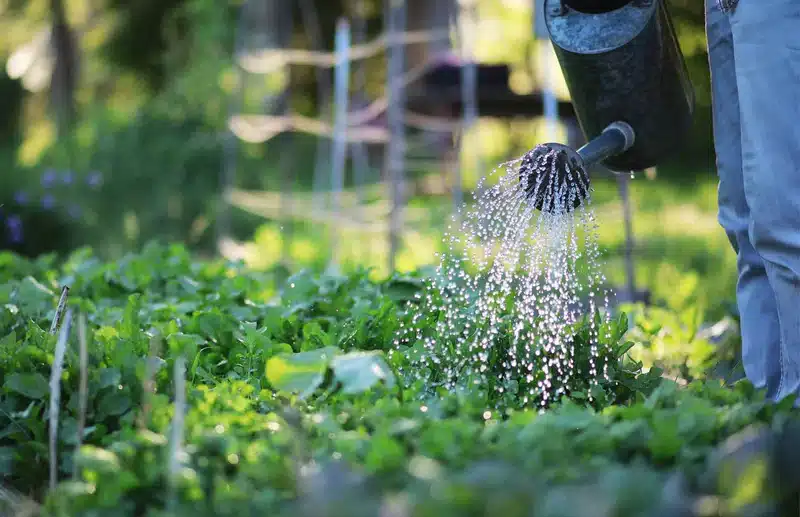In the changing agricultural world, sustainability is becoming increasingly important and water management is an important part of this. Water is becoming increasingly scarce, so using a sustainable watering system in your garden not only saves this precious resource, it also helps plants grow better and makes the environment greener. Here are some creative and eco-friendly ways to water your garden:
1. Drip Irrigation System
Using drip irrigation is very effective because it delivers water directly to the base of each plant, creating less waste. This technology reduces water consumption by up to 50% compared to traditional watering methods. Drip irrigation ensures that only the right amount of water reaches the roots, allowing plants to grow well while conserving water and other resources.
2. Collecting Rainwater:
Utilizing rainwater is an increasingly popular environmentally friendly method. To collect water from your roof, install a rain barrel or a more complex system to collect rainwater. You can then use the collected rainwater to water your garden, making you less dependent on other water sources. It’s a simple way to make the most of what nature has given us.
3. Smart Irrigation Controllers:
Smart irrigation control makes your garden’s watering system even better. These gadgets automatically change the timing of watering your plants based on the temperature and amount of water in the soil. Smart controls adjust the time and duration of watering based on real-time conditions, ensuring your plants get the right amount of water.
4. Greywater Recycling:
Gray water is the cleanest wastewater comes from household activities such as laundry and dishes, and can be used to water plants. Installing a gray water recycling unit allows you to reuse water that would normally go down the drain. By using gray water in your garden instead of a toilet, you save water while still providing nutrients to your plants.
5. Mulch:
Mulch has been used for a long time and has been proven to not only save water but also improve the land. Placing organic mulch around your plants can keep them moist, prevent weed growth, and keep the soil at the right temperature. This easy-to-use tip reduces the frequency of watering, saving time and water.
6. Drought-Tolerant Plants:
Choosing plants that are suitable for the temperatures in your area is another eco-friendly way to water. Choose plants that can grow in dry conditions and require less water to do well. These plants have adapted to dry conditions and can survive without sufficient water. This makes them an excellent choice for farmers who care about the environment.
7. Soil Moisture Sensors:
Adding a soil moisture monitor can help you use water more efficiently in your garden. These gadgets give you real-time information about soil moisture, so you can change how often you water your plants based on that information. By not watering when the soil moisture is good, you save water and ensure a better root environment for your plants.
8. Water-permeable Paving:
For paths and walkways in your garden, consider paving them to allow water to pass through. Compared to regular concrete surfaces, the porous material allows water to seep into the ground, replenishing the soil and stopping its loss. This helps the groundwater level to rise and reduces the need for additional watering.
9. Companion Plants:
Learn about the idea of companion planting, where certain plants are placed together in a way that helps each other grow. Certain groups of plants can help retain water in the soil because they create an environment that prevents the evaporation of water and keeps it there. By learning and using growing techniques from partners, you can ensure that your garden uses less water and grows better with other plants.
10. Contact Schools:
Educate people in your neighborhood about environmentally friendly ways to water their plants. To share your gardening information and experiences, you can organize workshops, write blog posts, or attend local gardening events. By telling others about the benefits of eco-friendly watering systems, you can help support the cause of sustainable gardening and water conservation.
Conclusion
Using these eco-friendly ways to water your garden is good for the environment and a good example for others to follow. As people who care about our world, we must do things that contribute to conservation and long-term survival. By using these eco-friendly gardening tips, you will not only keep your garden looking great, but you will also help the world become more sustainable and water-efficient.
FAQs
1. Why should I buy a sustainable garden watering method?
Sustainable watering practices help conserve water and keep plants healthy and the environment healthy. Doing these things will not only save you money and time but will also make your plants greener and stronger.
2. How does drip irrigation eliminate water waste?
Drip irrigation delivers water directly to the roots of each plant so it doesn’t evaporate or run off and be wasted. This precise watering method ensures that only the right amount of water reaches the roots, allowing plants to grow well with minimal water.
3. Can I use rainwater to water my plants?
While rainwater is great for watering your garden, it may not be enough when it is dry. You may want to combine rainwater harvesting with other eco-friendly ways of watering your plants to ensure they stay hydrated.
4. Is smart irrigation control difficult to set up?
Smart irrigation controls are easy for anyone to set up. Most types are easy to connect to your current irrigation system and setting them up usually only requires you to program them via a smartphone app. They make setting an automatic watering schedule quick and easy.
5. Which plants can survive dry conditions?
The plants that can survive and grow well in dry conditions have changed over time. Succulents, rosemary, and yarrow are some examples. Do some research and choose plants that are native to your region. There they can cope better with weather changes.
6. How does a soil moisture monitor work?
There are sensors on the ground that measure soil moisture. These gadgets give you real-time information so you can adjust watering frequency based on the actual needs of your plants. Soil moisture sensors help conserve water by preventing plants from getting too wet.

